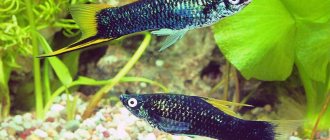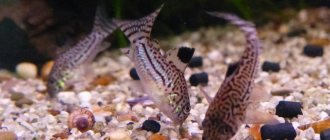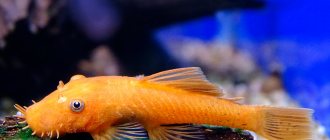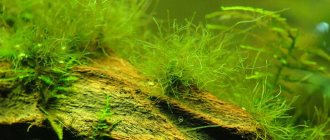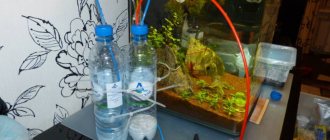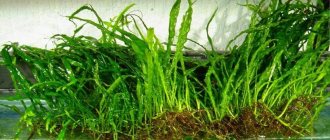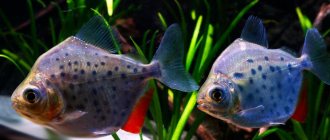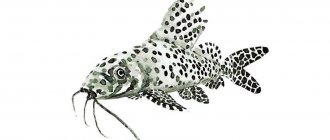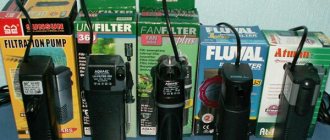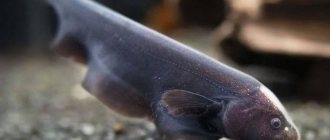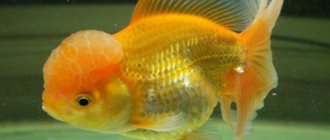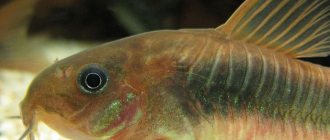Brocade pterygoplichthys (lat. Pterygoplichthys gibbiceps) is a freshwater fish from the chain-mail catfish family, which is often kept in an aquarium. The main disadvantage of Pterygoplichthus is the size to which it can grow even in a small volume. And considering that this fish is often bought by novice aquarists, its rapid growth and size become an unpleasant surprise for them. Next, you will find out where the brocade pterygoplichthus lives in nature, what size it can grow to, what it eats and with whom it is best to keep it.
Description and history of discovery
The brocade catfish pterygoplicht is one of the largest aquarium fish. This species was first discovered in 1845 by the Austrian ichthyologist and zoologist Kner. The scientist named it Ancistrus gibbiceps. Later, this species was included in the genus Pterygoplichts, but this happened much later, in 1980. And even later, already in 2003, the pterik was assigned to the genus Glyptoperichtidae. Under natural conditions, the size of this fish can reach up to 50 cm. However, the size of the fish in the aquarium is much smaller, and they directly depend on the size of the aquarium.
Useful tips
In order for a large pet to feel comfortable in the aquarium, and for the aquarist to be able to observe the life of the catfish for a long time, it is recommended to follow several tips:
- The brocade catfish's mouth is a suction cup, it is very strong. If you need to tear the fish off the surface, do it carefully so as not to injure the organ.
- For safety reasons, to avoid injuring your hands, touch the fish with gloves. The bone plates of catfish are quite sharp.
- Do not use gravel with sharp corners as soil or fill material. The abdomen and antennae of the catfish can be severely damaged.
- If the purchased catfish will later be sent to a specialized farm for breeding, then feed the individuals with bloodworms, it has a positive effect on milk and caviar.
- Buy food only in specialized stores. Even if they cost a little more.
You can see the brocade catfish and learn more about it from the following video:
Varieties of Pterygoplichthus
Today, science knows of 14 different varieties of pterygoplichths, but some exist only in nature and are extremely rare. As for the species that can be kept in an aquarium, there are 6 main varieties:
- Brocade catfish;
- Leopard catfish;
- Reticulated catfish;
- Pterygoplichts Yoselmann;
- Yellow sailfish;
- Golden catfish.
The brocade catfish is one of the largest, its size can reach more than half a meter in length. Such individuals live up to 20 years. It has an unusually shaped fin studded with spines. The fish got its name due to its unusual black and gold color. Individuals of the leopard catfish in an aquarium live only up to 10 years, their maximum size reaches 50 cm. This species received special attention due to its unusual shape and coloring, reminiscent of the skin of a leopard.
Brocade catfish
Leopard catfish
Reticulated catfish
Interesting fact!
The netted catfish is gray in color with a pattern in the form of a fine mesh; individuals of this species can live in an aquarium for up to 20 years.
Yoselman's Pterygoplicht is a dark-colored fish covered with small golden spots. Its maximum size can be 35 cm.
The yellow sail catfish, compared to other species, is small in size - only up to 30 cm. It is distinguished by a large sail-shaped fin and an unusual color in the form of dark chaotic spots on a black background.
The golden catfish is called an albino due to its color: it has a light golden color, non-standard for catfishes.
Are you hotter or colder?
Pteras have high adaptability to temperature conditions. A run-up from 22 to 30 degrees is suitable for a comfortable existence. They are undemanding to the presence of oxygen. If the fish rises up and swallows air, then it’s time to turn on the compressor.
Close attention should be paid to the presence of decomposition products in water. Recommended changes are from a quarter to half the volume weekly. Good filtration is important for comfortable keeping of brocade catfish. Poor water quality causes holes in the fin membranes and weakened immunity. If the bird is “sad,” you need to start by checking the water for nitrites, nitrates, and ammonia.
Natural habitat
The natural habitat of pterygoplichths is South America. They mainly live in the Amazon and Orinoco river basins; also, some species of this fish can often be found in the mountain rivers of the Andes. Pterygoplichts cannot be found in rapidly flowing fast rivers. They prefer silty areas of quiet rivers, shallows, etc. Quite often, bird species are combined into large groups.
By the way, those who consider catfish to be very calm and passive are mistaken. In nature, during the wet season, they become extremely active, the fish move a lot to get food. They eat algae and carrion as food. But this fish does not like dry periods; as a rule, it hibernates, burrowing deep into the silt.
On a note!
To date, pterygoplichts have been repeatedly spotted in the wild in Asia, Australia and other climate-friendly regions.
Another interesting feature of this fish is intestinal respiration. Pterygoplichts can capture air from the surface of the water and absorb it through the intestinal walls. The fish lives mainly at depth.
Habitat in nature
Habitat: Brazil, Ecuador, Peru and Venezuela. Brocade pterygoplichthus lives in the Amazon, Orinoco and their tributaries. During the rainy season it moves to flooded areas.
In slow-flowing rivers they can form large groups and feed together.
During the dry season, it digs long (up to a meter) holes in river banks, where it waits out the dry season. The fry are raised in these same burrows.
The name comes from the Latin gibbus - hump, and caput - head.
Behavior
In general, pterygoplichthys are known for their calm behavior. As a rule, they live on the bottom and lead a passive lifestyle. With some exceptions. In nature, their behavior is significantly different. More precisely, it directly depends on the time of year. During the rainy season, the fish are extremely active and can even rise to the surface to get food.
Pterygoplichthus feeds mainly on green algae and various types of carrion. The catfish also consumes oxygen from the surface of the water. Almost the rest of the time, most species of catfish prefer to hide at the bottom, buried in silt, and lead a sedentary lifestyle.
As for the behavior of pterygoplichts in the aquarium environment, they are extremely passive and calm. They spend most of their time at the bottom, hiding in algae or rocks; sometimes it may even seem that they have fallen asleep. Pterik does not interact or conflict with other types of aquarium fish. It is best to equip the aquarium with a special atmosphere, put stones on the bottom and plant algae so that the fish feels comfortable.
Compatibility
Large fish, and the neighbors should be the same: large cichlids (astronotus, red parrot, black-spotted warou, flower horn), knife fish, giant gourami, polypterus. The obvious advantages include the fact that the size and armor of pterygoplichts allows them to live with fish that destroy other fish, for example with flower horns.
As for herbalists, there is nothing for a catfish to do in an herbalist. This is a voracious rhinoceros that sweeps away everything in its path; it will quickly mow down everything from you and devour it, eat your plants.
Pterygoplichts grow slowly and can live in an aquarium for up to 15 years. Since the fish is nocturnal, it is imperative to provide shelters in which it can rest during the day.
In an aquarium, if a brocade fish chooses some kind of shelter, it will protect it not only from other brocade fish, but also from all fish. It rarely ends in injury, but it can be scary.
Brocade pterygoplichts fight with each other, straightening their pectoral fins. This behavior is typical not only for them, but also for the whole genus of chain-mailed catfish as a whole. By exposing its pectoral fins to the sides, the fish visually increases in size and, moreover, it is difficult for a predator to swallow it.
In nature, brocade catfish live in seasonal conditions. During the dry season, pterygoplichthys may burrow into the mud and hibernate until the rainy season.
Sometimes, when taken out of the water, it makes hissing sounds, scientists believe that this serves to scare away predators.
Appearance
The brocade catfish pterygoplicht has a rather original appearance, which is why it is very often chosen for your aquariums. This breed has an elongated, elongated body, the length of which can be over 50 cm. The body is covered on top and sides with a bony shell, and is soft on the abdominal side.
Like most species of catfish, the eyes and nostrils protrude significantly and are located on the top of the head, and the mouth is expressed in the form of a suction cup equipped with antennae. Thanks to the suction cups, this fish can hold well on vertical surfaces, such as the glass of an aquarium. Prominent bulging eyes can observe the situation not only in front of itself, but also from the side, and even behind. On the back of the fish there is a large sail-shaped fin, which contains more than 10 rays, and on both sides of the body there are fins similar to wings, arranged in such a way that they help the fish bury itself in the sand.
The color of the fish is golden, with many black thick spots. Thanks to its velvety smooth scales, similar to brocade, this fish got its name.
Compatibility and Behavior
Like any chain catfish, the behavior of Pterygoplicht is calm and non-conflicting. Thanks to its thick protective skin, the catfish is able to live even with such aggressive species as the flower horn. But aggression is possible within a species.
Glyptoperichthus has the best compatibility with large species:
- cichlids;
- polypterus;
- apteronothus;
- giant gouramis;
- Siamese cockerel.
You should not house the sticky fish with goldfish, veiled-tailed species, clumsy angelfish and discus fish: it eats their fins and scales. It is undesirable to choose competing fish as neighbors: cleaners, other catfish.
Differences between Pterygoplichthus and Ancistrus
Pterygoplichts and Ancistrus are considered the most popular species of Chain catfish. In terms of external characteristics, both of these species are very similar to each other, especially with regard to young individuals. However, they have many differences that directly affect the conditions of detention.
Firstly, fish have different body shapes. Pterygoplichthus has an elongated and slightly pointed head shape, while Ancistrus has a rounded head shape. This is especially clear if you look at the fish from above. And the whole body of ancistrus is more flattened, while pterygoplichts are much taller.
Attention!
One of the biggest differences is in size: Pterygoplicht can reach 50 cm in length, and Ancistrus no more than 15 cm, although in aquarium conditions they can reach the same small sizes.
In pterygoplichts the nostrils are always located above the eyes, while in ancistrus it is the opposite. Pterygoplichts can also be distinguished by the characteristic mustache on the lower part of the head and a pronounced hard dorsal fin, similar to a sail. The ancitrus catfish has a smaller, rounded fin.
Upon closer inspection, you can find differences in color: Ancistrus is black with many golden patterns, and Pterygoplichts is golden with many black spots.
Pterygoplichths are sometimes confused with other species of bottom fish.
Description of the fish
Brocade pterygoplichthys (Pterygoplichthys gibbicepsili) belongs to the chain catfish (breeders affectionately call their pets “pteryki”) , this is one of the largest representatives of the family.
Attention! The size of an adult individual can exceed half a meter in length! The height of the dorsal fin easily reaches 15 cm.
When purchasing a pterygoplicht, the aquarist must take into account both its size and the lifespan of the catfish: as long as this fish lives, almost no other representative of the reservoir lives that long.
With proper care, the brocade catfish easily overcomes the 15-year mark .
The body of the catfish is elongated, slightly flattened on top. The color is dark with light yellow veins, forming a beautiful spotted pattern.
The entire body, except the abdomen, is covered with bone plates that perform a protective function. The head of the catfish is large, with a characteristic mouth modified into a suction cup. Along the edges of the mouth there are dense, not too long antennae.
The suction force of the bird to the surface is such that it is not possible to tear the fish off without serious damage.
The fish's eyes are set high on the head, they are small and have a regular round shape. A distinctive feature of the bird is its protruding nostrils and a high, beautiful dorsal fin.
The fin consists of 12–13 rays, with the length of the first ray equal to the length of the catfish’s head.
A distinctive feature of brocade catfish is intestinal respiration. The fish periodically rises to the surface of the water to take in air with its mouth, and then sinks to depth.
Care and maintenance
The bird lives quietly in aquarium conditions and does not require any specific difficult conditions of detention. But there are still several conditions that must be adhered to when setting up an aquarium. Firstly, you must take into account that the brocade catfish is a large fish. And it requires a large aquarium volume. Under natural conditions, catfish can reach sizes of over half a meter. In an aquarium, of course, its size will be smaller, and it directly depends on the dimensions of the aquarium.
In this case, you must definitely monitor the oxygen level in the aquarium. Brocade catfish has 2 types of respiration: aeration and intestinal respiration. However, they cannot replace each other, so you need to ensure that the quality of the water always corresponds to what is required. If the owners notice that the fish often floats to the surface, this is a reason to check the oxygen level, since when feeling normal, the brocade catfish prefers to stay closer to the bottom and floats to the surface extremely rarely.
Contents of Pterygoplicht parchovog o
- not the most labor-intensive process, but it will still require constant monitoring and attention.
Keeping in an aquarium
It is not difficult to maintain, provided there is an abundance of food - algae and additional feeding.
The fish is good for beginners, but be aware of its size as it is often sold as an aquarium cleaner. Beginners buy, but the fish grow quickly and become a problem in small aquariums.
It is sometimes said that it is well suited for goldfish aquariums, however, this is not true. The conditions for goldfish and pterygoplichts are very different and you should not keep them together.
The aquarium should have good aeration and average water flow. It is better to use an external filter, since the fish are quite large and the water quickly becomes dirty.
Recommended temperature between 24-30 °C, pH 6.5-7.5, medium hardness. A weekly water change of about 25% of the volume is recommended.
Nutrition
The diet of the catfish pterygoplichtas consists of food of animal and plant origin. Plant foods should make up approximately 80% of the diet, and animal foods should make up about 20%. Often, owners feed their fish with natural vegetables: carrots, zucchini, lettuce. But vegetables greatly affect the quality of water in the aquarium and greatly clog it.
As for animal food, it is better to use bloodworms or tubifex. However, live bloodworms can lead to infection in the aquarium.
One of the best solutions is to use ready-made dry fish food. Their advantage is that such food already contains all the necessary nutrients and breaks down into small grains in the aquarium, as a result of which the water in the aquarium practically does not become clogged. Food in tablets can contain both vegetable and protein supplements.
Note!
It is necessary to place driftwood at the bottom of the aquarium; the fish gnaw the wood, thus obtaining cellulose, which has an extremely beneficial effect on the digestion of pterygoplichts.
Diseases
Pterochlitus very rarely gets sick. If the disease occurs, the main reasons are:
- increasing the level of organic matter in water;
- the absence of driftwood, the description was given above (they help with digestion);
- the appearance of ciliates.
Ciliates, the size of which is no more than 1 mm, appear in the aquarium and cause the disease ichthyophthyrosis. They penetrate the fins and gills of their prey. Because of this, the fish weakens, loses appetite, often swims to the surface and gradually dies from suffocation. If you can identify the first signs of the disease, you need to take the fish to a veterinary hospital. Sometimes it helps to cure fish by placing them in salt water or water heated to 30⁰C. If the disease has not disappeared, then it is better to buy special medications.
Compatibility with other fish
Pterygoplichts are quite peaceful fish, especially since they are passive most of the time and do not show aggression towards other inhabitants of the aquarium. In particular, cichlids, giant gouramis or polypterus will be good neighbors for catfish. Even Flowerhorn, which is dangerous for most aquarium fish, exists peacefully with catfish.
However, in relation to its own relatives, in particular ancistrus, pterygoplicht can behave quite aggressively and in every possible way survive unwanted guests from its territory. Therefore, it is better not to put two related species of fish in the same aquarium in order to avoid competition between them.
Content complexity
Brocade catfish can be kept with various fish, as its character is peaceful. They can be aggressive and territorial towards other catfish if they were not raised together.
Pterygoplicht needs a spacious aquarium, at least 400 liters per adult pair. It is necessary to place driftwood in the aquarium so that they can scrape off fouling from them, the main source of food for the brocade catfish.
They also absorb cellulose by scraping it from driftwood, which they need for normal digestion.
Brocade catfish is a nocturnal fish, so if you feed it, it is better to do it at night, shortly before turning off the lights.
Please note that although they primarily eat plant matter, catfish are also scavengers in nature. In an aquarium, they can eat the scales on the sides of discus and angelfish at night, so you should not keep them with flat and slow fish.
Also, brocade pterygoplicht can reach very large sizes (35-45 cm), when you buy them, they are quite small, but although they grow slowly, they can soon become too large for the aquarium.
Reproduction
Sexual maturity in Pterygoplichthus specimens occurs at approximately 3 years of age. The average size of the fish at that time is 20-25 cm. Males, as a rule, are brightly colored and larger than females. Fish breed only in the wild or on specially created farms, where all conditions are as close to natural as possible. In nature, catfish dig quite large holes and lay their eggs there. In this case, the male guards the entrance after the female lays eggs in the created tunnel. These tunnels reach a depth of several centimeters, which is why it is impossible to achieve the reproduction of fish in artificial conditions.
Catfish spawning always occurs at night; in one night a fish can lay from 100 to 500 eggs, but not all of them hatch into fish. The hatched fry are dark gray in color and covered with black dots. The fish become similar in color to their parents only after a few months.
Most of the fry for sale are raised on special farms located in the USA, Australia and South America. There, catfish breeding is carried out in large ponds that are as similar as possible to the fish’s natural habitat.
How to maintain and care
In terms of care, brocade catfish are not picky. However, artificially created conditions of detention should be as close as possible to natural ones. The following must be taken into account:
- What should be the volume of the aquarium?
- What additional equipment is needed;
- What to feed;
- Which fish can be kept in the same tank with?
- How do pterygoplichts reproduce?
- Differences between a male and a female.
Aquarium size
Since pterygoplichthys are not picky in terms of keeping, beginning aquarists often acquire them. But you need to remember: the fish will grow quite quickly, and accordingly, it will have little space in a small tank. Conclusion: it is advisable to buy only if you have a large aquarium.
In terms of the size of the tank for keeping such fish, a simple rule can be applied: the larger the better. The minimum volume of liquid for 1 individual is 150 liters. If the aquarium is small, the pterygoplicht will stop growing over time, which will lead to disruption of the natural processes in the individual’s body. As a result, the fish will become inferior, practically disabled, and accordingly, life expectancy will decrease significantly.
Optional equipment
Brocade catfish can adapt well to a lack of oxygen. However, experienced aquarists strongly recommend the use of additional aeration equipment. This is where a compressor comes to the rescue. You should also not allow the liquid in the tank to become contaminated: you need to use additional accessories in the form of filtering devices and elements.
What to feed
The diet of pterygoplichts must include a variety of foods. The ideal percentage is: 20% animal products, 80% plant products. Suitable vegetables:
- Zucchini;
- Cucumbers;
- Spinach;
- Carrot;
- Lettuce leaves.
You need to give dry food. A wide range of products of this type are presented in specialized stores. You can purchase goods from domestic and foreign manufacturers.
You should also remember about live food. As a rule, catfish pick up the remains of such food after other fish. Bloodworms, worms, and shrimp are suitable as live food.
The aquarium containing Pterygoplichts must contain some kind of driftwood. It can be birch, aspen, alder and other types. This is explained by the following: fish of this species love to feed on what has formed on the surface of the tree as plaque. In this way, they saturate their body with cellulose, thereby improving the process of digesting food.
You need to feed catfish in the evening, as they are active at night. It is better to throw food into the aquarium shortly before turning off the lighting in the room.
Compatibility with other fish
Pebbles, algae, and the above-mentioned driftwood (required) are used as filler for the aquarium. Pterygoplichts have a peaceful character, but it is not recommended to keep them together with some fish of other species. These include, for example, angelfish and discus. This is explained by the fact that catfish can eat scales from the sides of flat and slow inhabitants of the aquarium.
You should also avoid sharing the same tank with goldfish. The explanation here is quite simple - the need to create different conditions.
Problems may also arise in the case of content with competitors. These include other cleaners: Gerinocheilus, Ancitrus.
Despite their peaceful nature, pterygoplichts can show aggression towards similar inhabitants of the aquarium. If they did not initially grow up together, there will be a fight for territory. It is unlikely that mutual injuries will occur, but this factor must be taken into account.
Pterygoplichthus is a large fish, so its neighbors should also be of similar sizes. Polypterus, giant gouramis, knife fish, and large cichlids are ideal as cohabitants.
Reproduction
Such fish do not reproduce in aquariums, since it is very difficult, almost impossible, to create appropriate favorable conditions for prolongation of the species in a glass tank. In nature, females lay eggs in deep burrows they have made in advance. After the birth of offspring, males take full responsibility for the fry.
For the purpose of subsequent sale, pterygoplichts are bred on special farms in Australia, Asia, and the USA. Since the demand for them is quite high, this type of business brings good profits to the owners.
How to distinguish a female from a male
Determining the gender of a fish is very difficult. For this purpose, it is necessary to carefully examine the abdomen. This part of the body in “men” is flat, there is a so-called genital papilla on it, sticking vertically down. The female's belly is convex. A genital papilla is also present, but it is pressed against the body and is significantly smaller in size.
How to distinguish between a female and a female
Of course, males and females of the brocade pterygoplicht have some differences, but for an inexperienced person it can be very difficult to distinguish them from each other, especially for young individuals. Perhaps only an experienced aquarist will be able to easily determine the sex of an individual. Among the main differences are the following:
- Color and sizes. On average, males are several centimeters larger than female catfish. At the same time, they have a more saturated color, the color of the spots is more saturated, and in general the individuals look brighter.
- Pectoral fins. Large voluminous fins on the chest are present in both males and females. These fins are designed not only to swim, but also to burrow into the ground. In males, these fins are additionally equipped with spines.
- Genital papillae. Another difference is the different arrangement of the genital papillae in Pterygoplichthus specimens. In males they are noticeably protruding, while in females they are firmly pressed to the body.
But even all these conditions do not allow one to accurately distinguish a male from a female, so it is better to seek advice from an experienced aquarist.
Sexual demorphism in these catfish is rather weakly expressed
Let's put him in the herbalist
As mentioned above, relationships between pterygoplichths and plants do not always develop. And it's not just about the additional source of fiber. At night, these giants organize real races. Due to the large size of the fish, they are able to pull out entire bushes of greenery, significantly depleting the landscape. Herbalists often use double soil. A nutrient layer consisting of small particles is laid down. After the catfish promenade, the next morning there will be a mud curtain hanging in the aquarium. Therefore, pter and aquascape do not go together.
To preserve existing plants in the soil, it is worth laying a nylon or plastic mesh (grid). This way the roots will be able to gain a stronger foothold. It is a good idea to cover the growing points with large pebbles.
And finally, a few photos of the brocade catfish.
Diseases and prevention
Brocade pterygoplicht is one of the most unpretentious and disease-resistant aquarium fish. However, if not maintained correctly, even they can be susceptible to various diseases. For example, if the owner does not change the water in the aquarium regularly enough, solid metals and withdrawal products can accumulate in it, which negatively affect the condition of the fish and even lead to the appearance of holes in the fins of catfish.
You can identify a sick fish by a change in behavior: the catfish begins to behave restlessly or, conversely, excessively apathetic. If the color changes and the condition of the fish’s scales changes, then there is a high probability that the catfish has been exposed to a fungal disease. If purulent formations appear on the fish’s body and its abdomen turns white, this is a sure sign of bacterial infections.
To avoid fungal and bacterial diseases, you need to monitor the conditions in which the fish are kept and regularly clean the aquarium and update the water.
Here's some driftwood and seaweed. Bon appetit!
Owners of pterygoplichts often complain about an excess of waste products that disturb the appearance of the aquarium. The problem becomes especially urgent when catfish are overfed. Don’t forget that the brocade people pick up what is not eaten by the inhabitants of the upper strata. They use live food, and they don’t disdain dry food either. Therefore, catfish tablets do not need to be given every day. Better after one. In addition to industrial compounds, fish may be interested in cabbage or lettuce leaves scalded with boiling water, cucumbers, and pumpkin.
The brocade catfish definitely needs driftwood in the aquarium. Pteras use it as cover. If two individuals are kept at the same time, then it is better to put two driftwood. The fish slowly scrape off wood fibers, which are necessary for proper digestion.
The following proportions in the diet are recommended: 80% plant foods and 20% animal origin. If this rule is not followed, catfish begin to make up for the fiber deficiency through decorative plantings. With their graters they eat away bald spots on the leaves. Owners think that the plants lack minerals and increase feeding. Then it would be more correct to reconsider the nutrition of the Amazonian dragon.
Price
The cost of one individual brocade catfish can vary significantly depending on the size of the individual, its age, species and even region. For example, the average cost of one individual brocade pterygoplicht can be from 350 rubles. Often fry can be purchased even cheaper.
The younger the age and smaller the size of the catfish, the cheaper it will be to purchase. For example, the cost of a fish up to 7 cm in size can range from 250 rubles per individual. But the price of an adult catfish can be much higher and often reaches several thousand rubles. The purchase and arrangement of an aquarium will cost no less than 3-5 thousand.
It is best to purchase and equip it before purchasing the fish, since it is extremely dangerous for them to be outside the aquarium, even for several hours. It is best for novice aquarists to consult with experienced people when purchasing a catfish and equipment for it.
What are the diseases of brocade leopard catfish?
The Brocade Leopard Catfish is a hardy, disease-resistant fish. But he is also overtaken by a disease characteristic of aquarium fish - ichthyophthirosis. The disease is caused by ciliated ciliates. Ciliates are parasites ranging in size from 30 microns to 1 mm. Ciliated ciliates have a huge number of cilia on their body, with the help of which the parasite moves and delivers food to the mouth. Having reached the victim, the ciliated ciliates penetrate the skin, fins and gills. As a result of the vital activity of the parasite, white spots appear on the gills, fins and skin of the diseased fish. This is an obvious sign of illness. Sick fish weaken, float to the surface of the water and die from suffocation.
Reviews
Some are interested in the question of whether it is possible to breed catfish at home. The answer is no. They require special conditions for spawning, which are simply impossible to recreate at home. Fry sold in pet stores are bred on special farms. It cannot be said that pterygoplicht is a very capricious aquarium fish, but proper maintenance and care are very important for it.
Would you like to purchase Brocade Pterygoplicht for your own aquarium? Share in the comments!
Feeding of the brocade catfish
The diet of pterygoplicht must be varied. In the daily menu, animal feed should make up 20-25%, and plant food 75-80%. Suitable herbal products:
- lettuce leaves scalded with boiling water;
- zucchini, zucchini;
- cucumbers;
- carrot;
- spinach;
- cabbage.
These vegetables can be combined with special foods that are sold in pet stores. In this way, you can create an optimal diet for pterygoplicht. Frozen seafood, bloodworms or worms can be used as live food.
Most often they stay in shallow areas of rivers with weak currents, as well as in flooded areas during the rainy season.
You should not overfeed the catfish, otherwise they will stop cleaning the algae in the aquarium. Since Pterygoplicht prefers to be nocturnal, it is better to feed it in the evening before turning off the lights. These fish are quite slow and may miss the moment of feeding. It is very important that the fish have a reliable shelter for daytime rest. Here he will be able to hide from his relatives and from other inhabitants of the aquarium.
